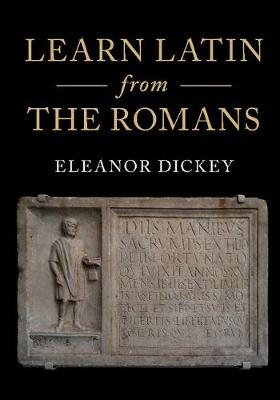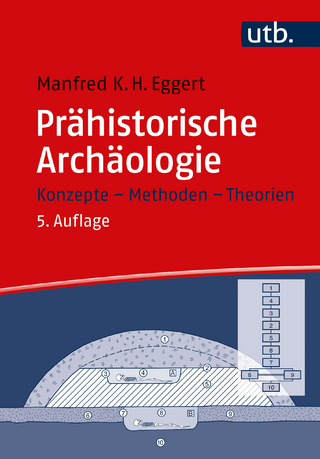
Learn Latin from the Romans
Cambridge University Press (Verlag)
978-1-107-14084-4 (ISBN)
Learn Latin from the Romans is the only introductory Latin textbook to feature texts written by ancient Romans for Latin learners. These texts, the 'colloquia', consist of dialogues and narratives about daily life similar to those found in modern-language textbooks today, introducing learners to Roman culture as well as to Latin in an engaging, accessible, and enjoyable way. Students and instructors will find everything they need in one complete volume, including clear explanations of grammatical concepts and how Latin works, both British and American orders for all noun and adjective paradigms, 5,000 easy practice sentences, and over 150 longer passages (from the colloquia and a diverse range of other sources including inscriptions, graffiti, and Christian texts as well as Catullus, Cicero, and Virgil). Written by a leading Latin linguist with decades of language teaching experience, this textbook is suitable for introductory Latin courses worldwide.
Eleanor Dickey was educated at Bryn Mawr College and the University of Oxford, has taught in Canada and the United States, and is currently Professor of Classics at the University of Reading. She is a Fellow of the British Academy and the Academia Europaea, and has published widely on the Latin and Greek languages and how they were studied in antiquity, including Greek Forms of Address (1996), Latin Forms of Address (2002), Ancient Greek Scholarship (2007), The Colloquia of the Hermeneumata Pseudodositheana (2012–15), Learning Latin the Ancient Way (2016) and An Introduction to the Composition and Analysis of Greek Prose (2016). She has extensive experience of teaching both Latin and Greek at all levels and has brought this experience to bear on her adaptations of ancient Latin-learning materials for modern students.
Preface; Introduction; The pronunciation of Latin; Part I: 1. Verbs: inflection and word order; 2. Nouns: nominative, vocative, and accusative of first and second declensions; 3. Adjectives: gender, agreement, neuters, and vocabulary format; 4. Tenses: future, perfect, and principal parts; 5. Genitive case, sum; 6. First and second conjugations, past participles; 7. Dative case, possum; 8. Second declension in -r and -ius, substantivization; 9. Ablative case, prepositions, eō; 10. Demonstratives and imperatives; 11. Reading texts; Part II: 12. Personal pronouns, partitive and objective genitives; 13. Present subjunctive, quis; 14. Third declension; 15. Subordination, imperfect subjunctive, purpose clauses; 16. Sequence of tenses; 17. Fourth and mixed conjugations; 18. Reading practice; 19. Infinitives and indirect statement; 20. Reflexives; 21. Third-declension adjectives; 22. Reading practice; Part III: 23. Demonstratives, ablative of agent; 24. Participles; 25. Relative clauses and volō; 26. Reading practice; 27. Deponent verbs: forms from first two principal parts; 28. Indirect commands; 29. Deponent verbs: perfect-stem forms; 30. Fear clauses and long sentences; 31. Reading poetry; Part IV: 32. Passive voice, agent and means; 33. Result clauses; 34. Fourth and fifth declensions; 35. Time and place; 36. Reading practice; 37. Nōlō and mālō; 38. Regular comparison; 39. Imperfect tense; 40. Irregular comparison, negatives; 41. Gerundives; 42. Reading practice; 43. Adverbs; 44. Pluperfect and future perfect tenses; 45. Impersonal verbs; 46. Perfect and pluperfect subjunctives; 47. More subordinate clauses; 48. Reading practice; Part V: 49. Ferō; 50. Conditional clauses; 51. Fīō; 52. Ipse and iste; 53. Reading practice; 54. Indirect questions; 55. Numbers; 56. Relative clauses with the subjunctive; 57. Ablative absolute; 58. Īdem, expressions of price and value; 59. Reading practice; 60. Gerunds I; 61. Gerunds II; Appendices: 62. How to use the appendices; 63. Further grammatical explanations and exercises; 64. Key to further exercises; 65. Alphabetical glossary of grammatical terminology; 66. The metre of Virgil's Aeneid; Cumulative vocabulary, Latin to English; Cumulative vocabulary, English to Latin; Index of grammatical topics covered; Index of Latin passages included.
| Erscheint lt. Verlag | 28.6.2018 |
|---|---|
| Zusatzinfo | 123 Tables, black and white; 1 Line drawings, black and white |
| Verlagsort | Cambridge |
| Sprache | englisch |
| Maße | 180 x 254 mm |
| Gewicht | 1210 g |
| Themenwelt | Schulbuch / Wörterbuch ► Wörterbuch / Fremdsprachen |
| Geschichte ► Allgemeine Geschichte ► Vor- und Frühgeschichte | |
| Geschichte ► Allgemeine Geschichte ► Altertum / Antike | |
| Geisteswissenschaften ► Geschichte ► Regional- / Ländergeschichte | |
| Geisteswissenschaften ► Sprach- / Literaturwissenschaft ► Anglistik / Amerikanistik | |
| Geisteswissenschaften ► Sprach- / Literaturwissenschaft ► Sprachwissenschaft | |
| ISBN-10 | 1-107-14084-6 / 1107140846 |
| ISBN-13 | 978-1-107-14084-4 / 9781107140844 |
| Zustand | Neuware |
| Haben Sie eine Frage zum Produkt? |
aus dem Bereich


